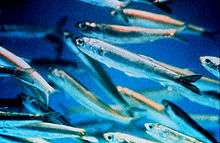Californian anchovy
The California anchovy or northern anchovy (Engraulis mordax)[1] is a species of anchovy found in the Pacific Ocean, ranging from Mexico to British Columbia.[2]
| Californian anchovy | |
|---|---|
 | |
| Scientific classification | |
| Kingdom: | |
| Phylum: | |
| Class: | |
| Order: | |
| Family: | |
| Genus: | |
| Species: | E. mordax |
| Binomial name | |
| Engraulis mordax Girard, 1854 | |
| Synonyms | |
| |
Relationship with humans
Commercial fishing
As sardine populations declined in the Pacific during the 1940s and 50's, fish packers in America started canning the more abundant local anchovies. Total hauls increased over this time from 960 tons in 1946 to 9,464 tons in 1947 and peaking at almost 43,000 tons in 1953. From 1949 to 1955, they were restricted for all uses but bait fish in California.[3] In 2010, reported American hauls totaled 2,100 metric tons. Most Californian anchovies today are fished for use in animal feed and as bait fish.[4]
In early July 2014,
a massive school of Northern anchovies could be seen migrating off the coast of La Jolla ... baffling scientists who said they haven't seen anything like it in more than 30 years.[5]
Recreational fishing
They are taken by anglers for use as bait or for personal consumption.[6]
Classification / Names
Common names | Synonyms | Catalog of Fishes (gen., sp.) | ITIS | CoL | WoRMS | Cloffa
Actinopterygii (ray-finned fishes) > Clupeiformes (Herrings) > Engraulidae (Anchovies) > Engraulinae Etymology: Engraulis: Greek, engraulis, -eos = anchovy (Ref. 45335); mordax: Genus name from the Greek 'engraulis' meaning anchovy; species name from the Latin 'mordax' meaning biting (Ref. 27436). More on author: Girard.
Environment / Climate / Range Ecology
Marine; pelagic-neritic; depth range 0 – 300 m (Ref. 265), usually ? - 219 m (Ref. 54433). Subtropical; 51°N - 21°N, 131°W - 108°W (Ref. 54433)
Length at first maturity / Size / Weight / Age
Maturity: Lm 9.6 range ? - ? cm. Max length : 24.8 cm SL male/unsexed; (Ref. 27436); common length: 15.0 cm TL male/unsexed; (Ref. 9988); max. published weight: 68.00 g (Ref. 56527); max. reported age: 7 years (Ref. 6884)
Short description morphology / Morphometrics
Dorsal spines (total): 0; Dorsal soft rays (total): 14-19; Anal spines: 0; Anal soft rays: 19 - 26; Vertebrae: 43 - 47. Snout quite sharply pointed; maxilla moderate, tip sharply pointed, reaching to or almost to hind border of pre-operculum, projecting well beyond tip of second supra-maxilla; tip of lower jaw below nostril. Gill rakers slender, long; absent on hind face of third epibranchial. Anal fin origin under about base of last dorsal fin ray. A silver stripe along flank, disappearing with age
Distribution countries / FAO areas / Ecosystems / Occurrences
Northeast Pacific: northern Vancouver Island south to Cape San Lucas, Baja California, Mexico. Two subspecies recognized: Engraulis mordax mordax from British Columbia to Baja California and Engraulis mordax nanus in Bays of California.
Biology
Usually found in coastal waters within about 30 km from shore, but as far out as 480 km, forming large, tightly packed schools. Enters bays and inlets. Feeds on euphausiids, copepods and decapod larvae, both by random filter-feeding and by 'pecking' at prey. Oviparous, epipelagic batch spawner (Ref. 6882). Spawns throughout the year, peaking once (Ref. 6882). Processed into fishmeal, used as bait for tuna, occasionally canned (Ref. 9298).
References
- "Engraulis mordax". IUCN Red List of Threatened Species. Retrieved 6 September 2012.
- "Seafood Handbook - Anchovy". SeafoodSource.com. Archived from the original on 2013-06-07. Retrieved 2012-09-06.
- "Engraulis mordax". IUCN Red List of Threatened Species. Retrieved 6 September 2012.
- "Northern Anchovy". NOAA FishWatch. Retrieved 6 September 2012.
- "Massive school of anchovies swarms off La Jolla". Los Angeles Times. 2014-07-08. Retrieved 2014-07-09.
- Daniello, Capt. Vincent. "A Guide to Saltwater Live Baits". sportfishingmag.com. Sport Fishing Magazine. Retrieved 21 June 2019.
External links
- Photos of Californian anchovy on Sealife Collection
| Wikimedia Commons has media related to Engraulis mordax. |
